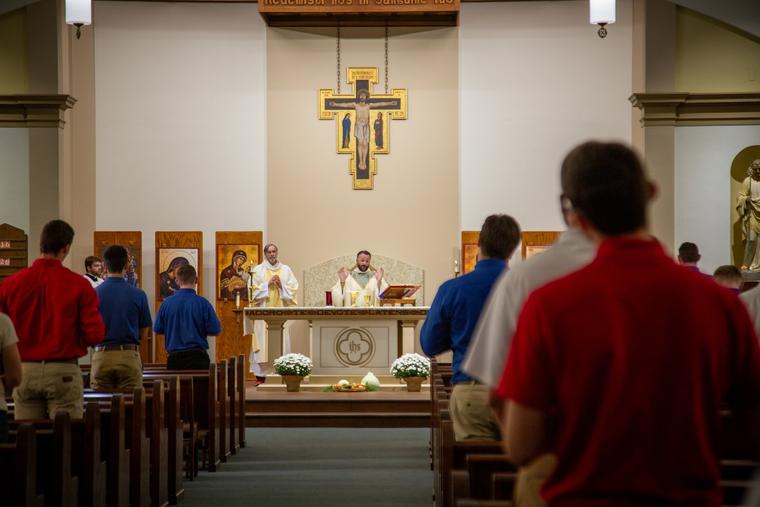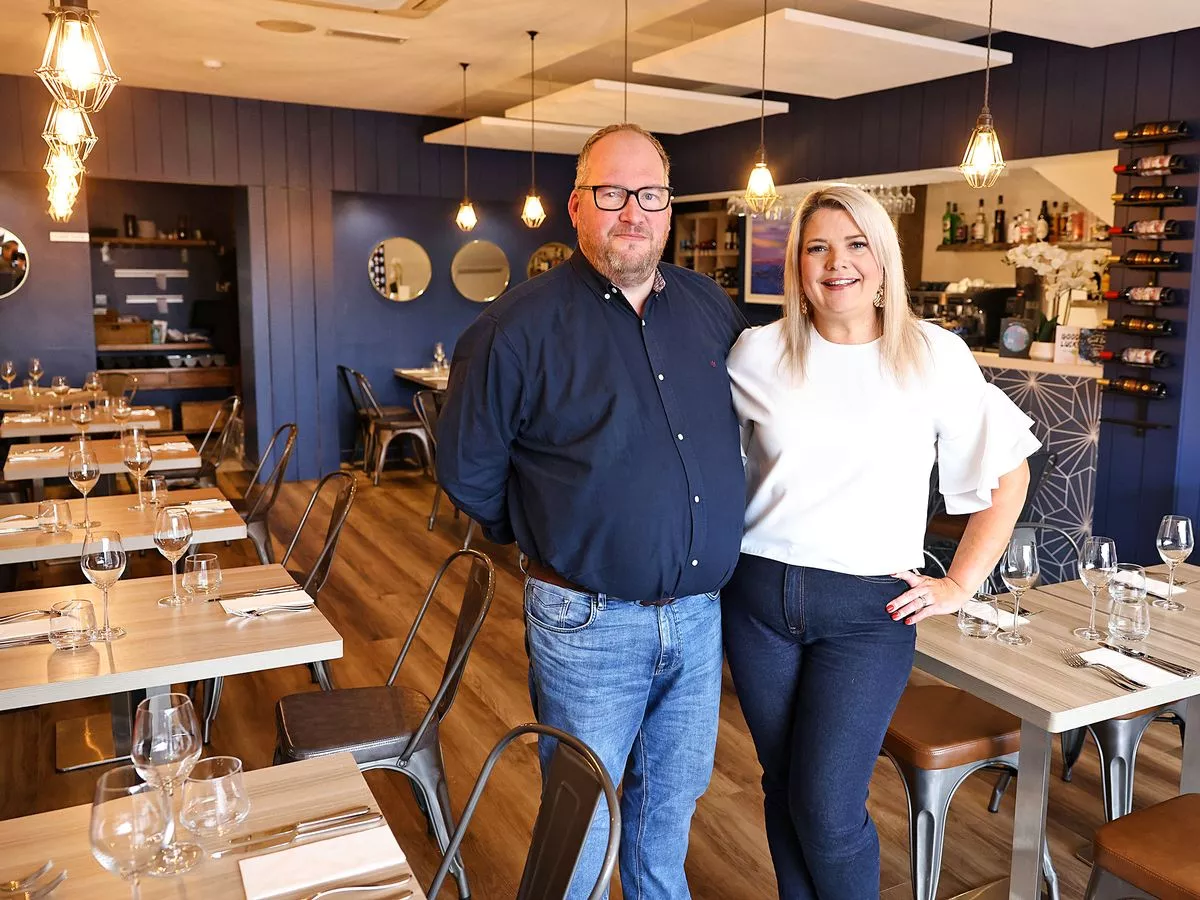Copyright ncregister

WICHITA, Kan. — It’s been well-documented that the Diocese of Wichita has one of the highest rates of priestly vocations in the country, routinely attracting more men to the seminary than archdioceses several times its size. While dioceses elsewhere see their priestly ranks shrink, Wichita is routinely ordaining nearly twice as many men as it needs. What’s Wichita’s secret? “It’s the million-dollar question. If I could write a book, I could retire tomorrow,” joked Father Chad Arnold, a Kansas native who serves as director of the St. Joseph House of Formation, an eclectic complex of brick buildings located on the grounds of St. Joseph parish in Wichita that houses most of the diocese’s seminarians. “I always feel inadequate for that question, because I stand on the shoulder of giants,” Father Arnold, who has served in his current role for two years, continued. “I live a blessed priesthood and a blessed life, and I did nothing to make that happen, other than try to be faithful to the Lord when he asked things of me.” The Diocese of Wichita, which serves just 116,000 Catholics in the southeast quadrant of Kansas, currently has 51 seminarians — putting Wichita on roughly similar footing, in terms of raw numbers, with numerous far larger U.S. dioceses such as Baltimore, Los Angeles, Brooklyn, Phoenix and Arlington, Virginia. Of those Wichita seminarians, 37 are currently living and studying at the House of Formation, alongside four seminarians from two other Kansas dioceses. The house, which Father Arnold said functions pragmatically as a minor seminary “in everything but name,” started in 2017 with seven men. Since then, it’s seen rapid expansion, seeing the conversion of previously unused rooms into bedrooms — not to mention building new buildings on the complex and taking over existing ones. Sacraments, Accessibility and Stewardship Fathers Arnold and Garett Burns — the diocesan director of vocational promotion — point to several concrete factors that make Wichita’s culture uniquely supportive of priestly vocations. First is a notable presence of Eucharistic adoration within the diocese; a majority of parishes have Eucharistic adoration chapels, most of them perpetual. One Wichita parish, Blessed Sacrament, recently celebrated 42 years of continuous perpetual adoration. “There's constantly people praying for vocations and just growing in the faith — families that have the Eucharist at the center of their lives,” Father Burns said. Building on the sacramental foundation in the diocese is the ready availability of priestly role models — with so many local young men being ordained year after year, it creates a snowball effect. It’s tremendously helpful for young men in the diocese to see their older peers become “good, happy, holy priests that love their priesthood, that work together well,” Father Burns said. “Growing up in Catholic schools, there was always a priest around at recess or in the lunchroom,” Father Burns recalled. “Being able to see their humanity made them seem not so far off … that a priest doesn’t just fall off a tree somewhere, but he’s a living, breathing human like me.” And speaking of priestly role models, Wichita’s relatively small size — at least in terms of population — works to its advantage. Data show that priests are generally spread less thin in smaller dioceses and are freer, compared to big dioceses, to invest their time in young men who may be interested in the priesthood. A 2025 study conducted by the nonprofit Vocation Ministry noted a metric called the “Priestly Availability Index” (PAI) that measures how accessible priests are to potential seminary candidates. Wichita was noted in that study as having a high PAI, meaning its priests, and even its bishop, are highly visible and accessible — something that larger dioceses often struggle to maintain. One manifestation of that fact in practice, Father Arnold said, is that Bishop Carl Kemme knows the door codes to the houses and sometime “just pops in for dinner” or joins the men for Holy Hour, fostering a personal and comfortable relationship. And no discussion of positive priestly role models would be complete without a mention of perhaps the famous Wichita priest, Venerable Father Emil Kapaun, whose cause for sainthood is well underway. A U.S. Army chaplain who was born in a tiny town about an hour from Wichita, Kapaun who died heroically in a North Korean prison camp in 1951. Scott Carter, coordinator of the Father Kapaun Guild in Wichita, told the Register that their “hometown” priest on the path to sainthood gives the diocese — and young men in particular — a joyful, unifying focal point and a model to “cheer on” and imitate. Ordained in 1940, Kapaun is remembered for bringing the sacraments to the men on the front lines during the Korean War and pouring himself out for others, even to the point of his own death. Kapaun’s legacy, Carter explained, calls young men in Wichita to courage, humility and service, and his battlefield bravery challenges and inspires them. “He was going out to the periphery, to the front lines. He was running towards the bullets when it’s so easy to want to run away,” Carter said. Kapaun’s image is ubiquitous in Catholic Wichita, and the men at the formation house often reflect on the life and legacy of Father Kapaun through Holy Hours at his tomb at the downtown cathedral, Father Arnold said. Another crucial factor in Wichita is the unique way that its Catholic parishes and schools are funded. The schools operate not by tuition, but through a parish-based “stewardship” model — yet to be replicated in any other diocese — developed in the 1980s under Bishop Eugene Gerber. Under the stewardship model, Wichita Catholics are explicitly asked to commit to a tithe of 10% of their gross income; 8% goes to their parish and 2% to charities of their choice. This system produces notably higher revenues for parishes and schools than in most dioceses, which in turn allows the schools to welcome more students and gives Catholics — those whose tithing made it possible — a greater sense of being part of the mission of the parish and school than they would otherwise have had. “If we recognize that Jesus Christ gave of himself completely, he emptied himself and took a form of a slave on our behalf, that he who is rich became poor so that we who are poor might become rich, when we start recognizing that Jesus gave everything, then stewardship becomes a part of our process by which we give everything in return,” explained Father Jarrod Lies, diocesan vicar for stewardship and evangelization. “Stewardship is the ability for us to see and respond to the beautiful things that God has given us, to be able to recognize that we are both gifted, as well as in a world that’s broken, such that we also need to share our gifts to be able to bring about that greater beauty of love of God. … As St. Paul says, it helps us carry one another’s burdens.” Forming the Men Once young men in Wichita have made the commitment to enter seminary, the spiritual formation they receive at the St. Joseph House of Formation is structured around a rigorous prayer life, formal instruction and demanding interior work — with plenty of recreation and fun thrown in. The house operates on a less institutional, more family-oriented philosophy than most seminaries; like in most real family homes, there’s no hired staff. Seminarians are required to do all their own cleaning and cooking, which is an intentional effort to instill rudimentary family skills and combat unhealthy lifestyles, such as a dependence on fast food, that priests sometimes adopt. The house also provides “skills classes” three times a semester focusing on practical skills like plumbing, electricity, woodworking and automotive repair — skills deemed fruitful for future priests, especially those in small country parishes. Right now, the seminarians are even raising chickens out back. The men live directly next to a parish with a school, giving them practical exposure to the daily life of a parish priest; there are even opportunities to spend their free time interacting with the children at the school. A firsthand look at parish life — literally living on the grounds — is an important aspect that was often missing in older seminary models, Father Arnold noted. There’s a key focus on spiritual and human growth in the four years that men spend at the House of Formation. While living together and receiving their initial formation in the parish-based setting and building community through fraternity and leisure, the seminarians also take philosophy classes through Newman University, a Catholic college nearby. From there, they go on to their theology years at larger seminaries, such as Mundelein in Chicago and Mount St. Mary’s in Maryland. Seminary takes seven years, and since the House of Formation is only just turning eight, 2024 was only the first year that House of Formation graduates started being ordained. It’s a special and meaningful experience for the current guys to have alumni return and celebrate Mass for them, to remind them that “there is an end” to all their efforts, Father Arnold said. Faith Passed Through Families While Wichita’s vocational programs and practices are strong, both Father Arnold and Father Burns emphasize that the foundation of vocations is still the Catholic family. “I think we’re blessed in the Midwest,” Father Burns said. “Families, in large part, have maintained those traditional values. And that does so much more than any program I can institute.” Seminarian Andrew Meyer told the Register that, from an early age, he was immersed in parish life, thanks in part to his mother’s long-standing involvement at Wichita’s Church of the Blessed Sacrament as a parish office staff member. That steady presence gave Meyer a front-row view of the everyday rhythms of a faith community and introduced him to priests who served as positive role models. Echoing Father Burns, Meyer said it was key for him to see their example, as it made the idea of priesthood something tangible, rather than abstract. Growing up, Meyer would seek permission, even as an elementary student, to spend Friday study halls in the parish adoration chapel with a small group of classmates once schoolwork was finished. He said that practice, combined with his Catholic education, reinforced a key insight: Learning about faith is important, but it’s meant to lead to a relationship with Christ. The integration of classroom learning, personal prayer and community life created a strong foundation. As he moved into high school and graduation, Meyer continued to prayerfully consider his path forward, and the choice that brought the most peace to his heart was entering seminary. He described his discernment as a process of consistent thought, prayer and conversation with trusted priests and mentors. Now in his third year at the formation house, Meyer reflects on that decision as the natural outcome of years of quiet formation. “I think the priests, my parents, the teachers and the schooling all culminated in adoration, actually being with the Lord — that’s what led me here,” he said. Benjamin Weber, a fellow seminarian who also grew up in Blessed Sacrament parish, said his interest in the priesthood began very early — around first or second grade — and never fully faded as he grew older. While there were times when the sense of calling was less distinct, he described it as a steady presence that made the decision after high school feel natural. “I have other older friends who are seminarians as well, but my discernment wasn’t necessarily influenced by that. It was more like a personal call in my heart,” he explained. Like Meyer, Weber said he spent many hours in prayer at the parish adoration chapel and credits that time with helping him clarify his next steps. For him, those moments of quiet focus were essential in confirming that seminary formation was the right path. Father Burns encouraged young people — both men and women — to discern through small daily steps rather than grand plans. “A lot of times people get paralyzed wondering if they’re ready to be a priest or to get married. But can you say, ‘The Lord is calling me to pray every day,’ or to go to Mass one extra time a week, or to serve the poor once a month? Taking each of those little steps builds the muscle of commitment. Then it’s not so big at the end of the line to propose marriage or to lay down your life in ordination — because you’ve strengthened that muscle little by little.” That approach — patient, prayerful and personal — sums up Wichita’s “secret.” The diocese’s vocation boom is less the result of a single program than of an entire Catholic ecosystem: families nourished by the Eucharist, young men who see and interact with joyful and holy priests, and a supportive school and parish environment. For Father Arnold, the shift from pastor to seminary formator has been transformative in his own journey of faith. “As a pastor, you spend a lot of your time convincing people to live the Gospel. When I moved from being a pastor to here, 90% of my focus shifted from convincing people to live the Gospel to showing them how,” Father Arnold explained. “It has challenged me in my own growth for holiness and sanctity. I hope I have served the men well.”



